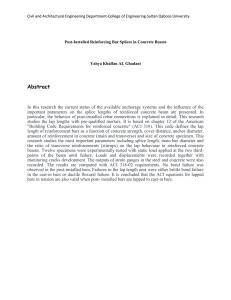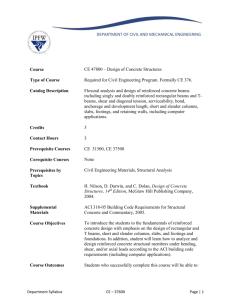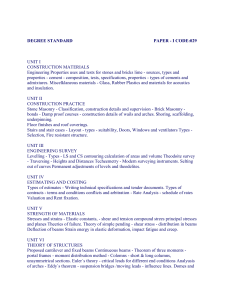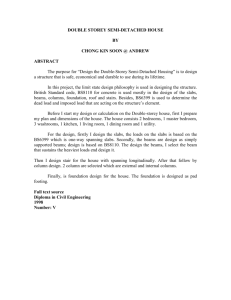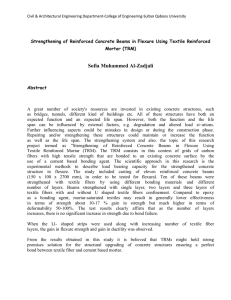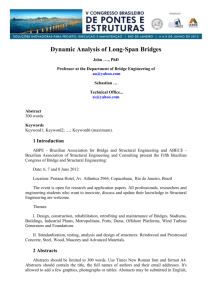Research Journal of Applied Sciences, Engineering and Technology 11(7): 765-769,... DOI: 10.19026/rjaset.11.2039
advertisement
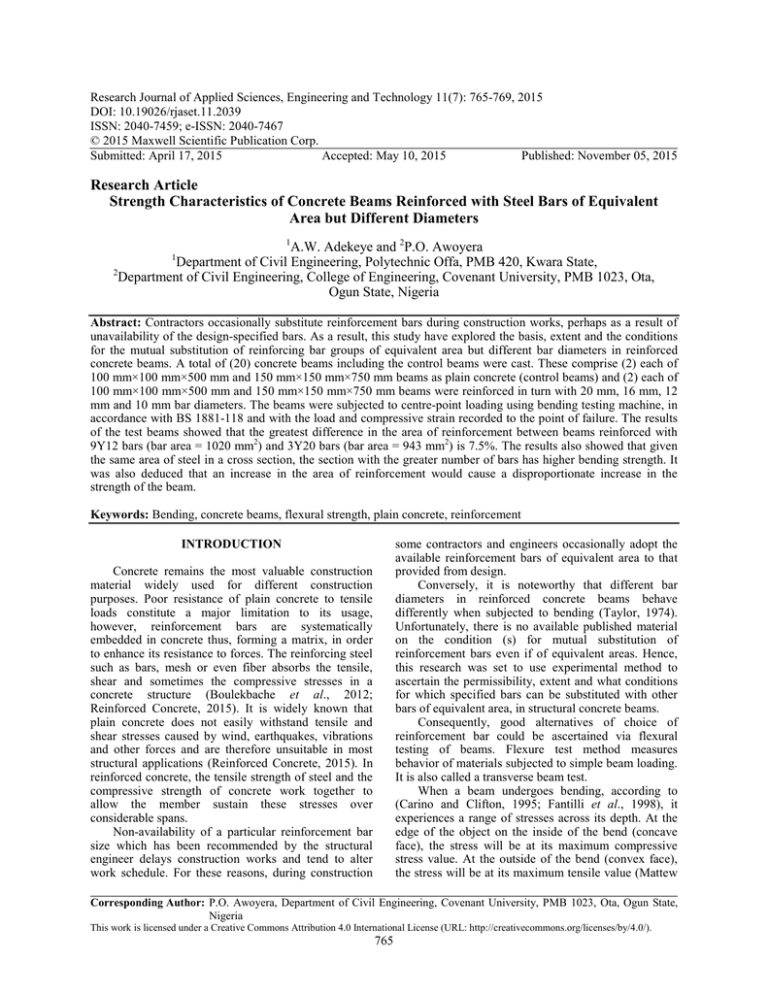
Research Journal of Applied Sciences, Engineering and Technology 11(7): 765-769, 2015 DOI: 10.19026/rjaset.11.2039 ISSN: 2040-7459; e-ISSN: 2040-7467 © 2015 Maxwell Scientific Publication Corp. Submitted: April 17, 2015 Accepted: May 10, 2015 Published: November 05, 2015 Research Article Strength Characteristics of Concrete Beams Reinforced with Steel Bars of Equivalent Area but Different Diameters 1 A.W. Adekeye and 2P.O. Awoyera Department of Civil Engineering, Polytechnic Offa, PMB 420, Kwara State, 2 Department of Civil Engineering, College of Engineering, Covenant University, PMB 1023, Ota, Ogun State, Nigeria 1 Abstract: Contractors occasionally substitute reinforcement bars during construction works, perhaps as a result of unavailability of the design-specified bars. As a result, this study have explored the basis, extent and the conditions for the mutual substitution of reinforcing bar groups of equivalent area but different bar diameters in reinforced concrete beams. A total of (20) concrete beams including the control beams were cast. These comprise (2) each of 100 mm×100 mm×500 mm and 150 mm×150 mm×750 mm beams as plain concrete (control beams) and (2) each of 100 mm×100 mm×500 mm and 150 mm×150 mm×750 mm beams were reinforced in turn with 20 mm, 16 mm, 12 mm and 10 mm bar diameters. The beams were subjected to centre-point loading using bending testing machine, in accordance with BS 1881-118 and with the load and compressive strain recorded to the point of failure. The results of the test beams showed that the greatest difference in the area of reinforcement between beams reinforced with 9Y12 bars (bar area = 1020 mm2) and 3Y20 bars (bar area = 943 mm2) is 7.5%. The results also showed that given the same area of steel in a cross section, the section with the greater number of bars has higher bending strength. It was also deduced that an increase in the area of reinforcement would cause a disproportionate increase in the strength of the beam. Keywords: Bending, concrete beams, flexural strength, plain concrete, reinforcement some contractors and engineers occasionally adopt the available reinforcement bars of equivalent area to that provided from design. Conversely, it is noteworthy that different bar diameters in reinforced concrete beams behave differently when subjected to bending (Taylor, 1974). Unfortunately, there is no available published material on the condition (s) for mutual substitution of reinforcement bars even if of equivalent areas. Hence, this research was set to use experimental method to ascertain the permissibility, extent and what conditions for which specified bars can be substituted with other bars of equivalent area, in structural concrete beams. Consequently, good alternatives of choice of reinforcement bar could be ascertained via flexural testing of beams. Flexure test method measures behavior of materials subjected to simple beam loading. It is also called a transverse beam test. When a beam undergoes bending, according to (Carino and Clifton, 1995; Fantilli et al., 1998), it experiences a range of stresses across its depth. At the edge of the object on the inside of the bend (concave face), the stress will be at its maximum compressive stress value. At the outside of the bend (convex face), the stress will be at its maximum tensile value (Mattew INTRODUCTION Concrete remains the most valuable construction material widely used for different construction purposes. Poor resistance of plain concrete to tensile loads constitute a major limitation to its usage, however, reinforcement bars are systematically embedded in concrete thus, forming a matrix, in order to enhance its resistance to forces. The reinforcing steel such as bars, mesh or even fiber absorbs the tensile, shear and sometimes the compressive stresses in a concrete structure (Boulekbache et al., 2012; Reinforced Concrete, 2015). It is widely known that plain concrete does not easily withstand tensile and shear stresses caused by wind, earthquakes, vibrations and other forces and are therefore unsuitable in most structural applications (Reinforced Concrete, 2015). In reinforced concrete, the tensile strength of steel and the compressive strength of concrete work together to allow the member sustain these stresses over considerable spans. Non-availability of a particular reinforcement bar size which has been recommended by the structural engineer delays construction works and tend to alter work schedule. For these reasons, during construction Corresponding Author: P.O. Awoyera, Department of Civil Engineering, Covenant University, PMB 1023, Ota, Ogun State, Nigeria This work is licensed under a Creative Commons Attribution 4.0 International License (URL: http://creativecommons.org/licenses/by/4.0/). 765 Res. J. Appl. Sci. Eng. Technol., 11(7): 765-769, 2015 et al., 2014). These inner and outer edges of the beam are known as the extreme fibers. Jakubovskis et al. (2014) articulated that most materials fail under tensile stress before they fail under compressive stress, so the maximum tensile stress value sustained before failure is its flexural strength. Designers of reinforced concrete use a theory based on flexural strength in determining concrete beam strengths (ACI Commitee 544, 1988). However, agencies not using flexural strength generally find the use of compressive strength convenient and reliable to judge the quality of reinforced concrete beams (Ritchard and Norman, 1991). Flexural tests have been conducted on beams with different diameters of reinforcement bars. Teo et al. (2006), investigated the flexural strength behaviour of reinforced concrete beams with different bar diameters. They tested (4) reinforced concrete beams under centrepoint loading. The beam dimensions are as follows: 102 mm×203 mm, 102 mm×406 mm, 127 mm×610 mm and 152 mm×610 mm; but all the beams were equally spanned at 4500 mm and reinforced with Y12, Y14, Y16 and Y20, respectively. The beam flexural strengths obtained were 95, 71, 80 and 60 N/mm2, respectively. In another related study, Rashid and Mansur (2005) studied the flexural behaviour of High Strength Concrete (HSC) beams. Sixteen reinforced concrete beams were evaluated. Their findings showed that stresses generated by shrinkage of concrete and the creep associated with it significantly affect the cracking moment and service load deflection of reinforced HSC beams. On the other hand, Mangat and Elgarf (1999) investigated one hundred and eleven (111) underreinforced concrete beams which underwent different degrees of reinforcement corrosion to determine their residual flexural capacity. In their results, there were marked reductions in flexural strength due to reinforcement corrosion, which was caused primarily by the breakdown of bond at the steel/concrete interface. Hence, to ascertain the limits was to mutual substitution of reinforcement bars in concrete, this study aims to evaluate the bending behaviour of beams reinforced with reinforcement bars of equivalent area but different bar diameters. 100 Particle size distribution Fine aggregates Percent finer (%) 80 60 40 20 0 0.001 0.01 1 0.1 Particle size (mm) 10 Fig. 1: Particle size distribution curve for the fine aggregate compressive load and the resistance of aggregate to impact loads respectively. Moreover, sieve analysis was also conducted on the fine aggregates, in order to identify the gradation of the aggregate and more so, to see if it is suitable for various civil engineering purposes. The result of the particle size distribution curve for the fine aggregate is presented in Fig. 1. Study has shown that the material passing the BS No. 200 sieve (aperture: 75 µm) is clay or silt, or combination of the two. The percentage of these in the fine aggregate is a factor that must be considered in the strength of concrete produced from sand. As described in BS 812-2, the total quantity of clay and silt in natural sand shall not exceed 4% by weight when determined by the field settling test decantation method. However, the percentage passing of clay and silt from the particle size distribution test carried out on the sand used for the concrete beams is 3.89%. This shows that the fine aggregate has the required strength and also meets the specification for the tested concrete beams. Results obtained from ACV and AIV tests on the coarse aggregate were 27 and 20% respectively. These values fall within limits (23 to 30%) for ACV and (17 to 21%) for AIV respectively, for BS standards test results for aggregates; thus the material is granite. The bending strength test conducted on concrete beams satisfied the requirements of British Standards Institution (1983), using the centre-point loading method. A total of (20) concrete beams were produced. For unreinforced beams (control sample), (2) each of 100 mm×100 mm× 500 mm and 150 mm×150 mm×750 mm beams and (2) each of 100 mm×100 mm×500 mm and 150 mm×150 mm×750 mm beams reinforced in turns with 20 mm, 16 mm, 12 mm and 10 mm bar, were subjected to bending. Thus, about 943 mm2 area of reinforcement was considered for all beams. The test samples have nominal depth d, for both the 100 mm×100 mm and 150 mm×150 mm cross sections and spans of 500 mm and 750 mm, respectively. The bottom bars include 3Y20, 5Y16, 9Y12, 12Y10 for the beams reinforced with 20 mm, 16 mm, 12 mm and MATERIALS AND METHODS The study focused on determination of the bending strength of reinforced concrete beams samples, whereas preliminary tests such as Aggregate Crushing Value (ACV), Aggregate Impact Value (AIV) and particle size distribution of aggregates were obtained prior to concrete making. Both ACV and AIV tests were conducted in accordance with the requirements of British Standards Institution (1990a, 1990b) respectively, the tests were required in order to ascertain the resistance of aggregate to crushing under a gradually applied 766 Res. J. Appl. Sci. Eng. Technol., 11(7): 765-769, 2015 required dimensions for 100 mm×100 mm×500 mm and 150 mm×150 mm×750 mm beams, respectively. The concrete cover to reinforcement was limited to 20 mm in alignment with the importance of concrete cover highlighted by Awoyera et al. (2014). A mix proportion of 1:2:4 by volume of cement, sand and granite aggregates with water-cement ratio of 0.45 were considered for casting the beams. Reinforcement bars were placed in the lubricated formwork and filled with concrete in three layers, each layer compacted with 25 blows using tamping rod. After the setting of the concrete beams had taken place, the formwork was carefully detached and the beams were placed in a water tank and cured for 28 days. After the curing period, beams removed from the water tank were subjected to bending strength tests. During testing, each of the samples were placed in Fig. 2: Reinforcement details for the test beams 10 mm bars respectively whereas the top bars comprise 3Y10 for all the beams except the beams reinforced with 12Y10 for which the top bars were 4Y10. However, 4 mm and 6 mm diameter bars were used as space bars and links for all beam samples reinforced with 3Y20, 5Y16, 9Y12 and 12Y10. The arrangement of reinforcement and beam details are presented from Figs. 2 to 4. The formwork for the concrete beams was made from dry Iroko wood, sawn and smoothened to the (a) (b) (c) (d) Fig. 3: Details of the reinforced concrete beams showing top and bottom bars for 100 mm×100 mm cross section (a) (b) (c) (d) Fig. 4: Details of the reinforced concrete beams showing top and bottom bars for 150 mm×150 mm cross section 767 Res. J. Appl. Sci. Eng. Technol., 11(7): 765-769, 2015 position in the flexural testing machine, correctly centered with the longitudinal axis of the beam at right angle to the supporting and load-applying rollers. This ensured that the top and bottom surfaces of the beam are parallel so that the loading was uniform across the width of the beam. The load was then applied steadily and without shock and increased continuously at 200 N/s for 100 mm×100 mm×500 mm and 450 N/s for 150 mm×150 mm×750 mm beams, in accordance with British Standards Institution (1983). The concrete beams were subjected to centre-point loading which was done simultaneously with concrete surface mounted strain gauge, used in measuring strain in the reinforced concrete beams. The strain gauge started to read immediately when the loading of the beams commenced until the breaking load was achieved. The loading rate was maintained without change until failure occurred. The maximum load read on the scale was recorded as the breaking load. Plain concrete 3Y20 Reinfored beams 5Y16 Reinfored beams 9Y12 Reinfored beams 12Y10 Reinfored beams 160 Stress (N/mm 2 ) 120 80 40 0 0 0.001 0.003 0.002 Strain 0.004 Fig. 5: Bending strengths for 100×100×500 mm beams Plain concrete 3Y20 Reinfored beams 5Y16 Reinfored beams 9Y12 Reinfored beams 12Y10 Reinfored beams 80 RESULTS AND DISCUSSION Figure 5 and 6 present the results of bending tests obtained for 100 mm×100 mm×500 mm and 150 mm×150 mm×750 mm beams, respectively. The figures revealed the stresses and strains attained on each beam which showcased their bending capacity. However, the summary of the bending strengths at failure for the two sizes of beams is presented in Fig. 7. The result obtained showed that beams reinforced with 9Y12 main bars have greater bending strengths than the other beams reinforced with 3Y20, 5Y16 and 12Y10. The percentage relative difference in the bending strength as well as their corresponding percentage relative difference in area of reinforcement can be deduced. Specifically, as the area of reinforcement increased from 943 mm2 (for 3Y20 bars) to 1010 mm2 (for 5Y16 bars), representing a 6.6% increase in bar area, the increase in the bending strength increased by 16.6 and 12.9%, for both the 100 mm×100 mm×500 mm and the 150 mm×150 mm×750 mm beams, respectively. In addition, as the area of reinforcement increased from 1010 mm2 (for 5Y16 bars) to 1020 mm2 (for 9Y12 bars), representing a 1% increase in bar area, the bending strength increased by 11.9%, for the 100 mm×100 mm×500 mm beams; whereas for the 150 mm×150 mm×750 mm beams the bending strength increased by 10.1%. Also, as the area of reinforcement decreased from 1020 mm2 (for 9Y12 bars) to 943 mm2 (for 12Y10 bars), representing a 8.2% decrease in bar area, the bending strength decreased by 19.2%, for the 100 mm×100 mm×500 mm beams; whereas for the 150 mm×150 mm×750 mm beams the bending strength decreased by 14.2%. Hence, it can be deduced that as the area of reinforcement increases, the bending strength of the reinforced concrete beams increase as well. Stress (N/mm2 ) 60 40 20 0.0 030 02 5 0.0 020 0.0 01 5 0.0 0.0 0 0.0 005 0 10 0 Strain Fig. 6: Bending strengths for 150×150×750 mm beams 100×100×500 mm beams 150×150×750 mm beams 160 5Y16 12Y10 3Y20 120 Stress (N/mm 2 ) 9Y12 9Y12 80 12Y10 5Y16 3Y20 40 Plain concrete Plain concrete 0 0 0.001 0.002 Strain 0.003 0.004 Fig. 7: The behavior of the concrete beams under bending at failure Thus, an increase in the area of reinforcement would cause a disproportionate increase in the strength of the beam. 768 Res. J. Appl. Sci. Eng. Technol., 11(7): 765-769, 2015 British Standards Institution, 1990a. BS 812-110: Testing Aggregates-part 110: Methods for Determination of Aggregate Crushing Value. British Standards Institution, London. British Standards Institution, 1990b. BS 812-112: Testing Aggregates-part 112: Methods for Determination of Aggregate Impact Value. British Standards Institution, London. British Standards Institution, 1983. BS 1881-118: Testing Concrete-part 118: Methods for Determination of Flexural Strength. British Standards Institution, London. Carino, N.J. and J.R. Clifton, 1995. Prediction of Cracking in Reinforced Concrete Structures. NISTIR 5634, U.S. Department of Commerce, National Institute of Standards and Technology, Gaithersburg. Fantilli, A., D. Ferretti, I. Iori and P.Vallini, 1998. Flexural deformability of reinforced concrete beams. J. Struct. Eng., 124(9): 1041-1049. Jakubovskis, R., G. Kaklauskas, V. Gribniak, A. Weber and M. Juknys, 2014. Serviceability analysis of concrete beams with different arrangements of GFRP bars in the tensile zone. J. Compos. Constr., 18(5): 04014005. Mangat, P.S. and M.S. Elgarf, 1999. Flexural strength of concrete beams with corroding reinforcement. ACI Struct. J., 96(1): 149-158. Mattew, M., K. Shenoh and K.S. Ravishanka, 2014. Flexural strength of E-glass-reinforced PMMA. Int. J. Experiment. Dent. Sci., 3(1): 24-28. Rashid, M.A. and M.A. Mansur, 2005. Reinforced high-strength concrete beams in flexure. ACI Struct. J., 102(3): 462-471. Reinforced Concrete, 2015. In Encyclopedia Britannica. Retrieved from: http://www.britannica.com/ EBchecked/topic/496607reinforced-concrete. (Accessed on: 9/04/2015) Ritchard, O.M. and R.N. Norman, 1991. Concrete mixture evaluation and acceptance for air field pavements. Proceeding of the ASCE Air Field Pavement Conference, NRMCA No. 178. Taylor, H.P.J., 1974. The Fundamental Behaviour of Reinforced Concrete Beams in Bending and Shear. Proceeding of ACI-ASCE Shear Symposium. Ottawa, 1973 (ACI Special Publication SP 42). ACI, Detroit, pp: 43-77. Teo, D.C.L., M.A. Mannan and J.V. Kurian, 2006. Flexural behavior of reinforced lightweight concrete beams made with Oil Palm Shell (OPS). J. Adv. Concr. Technol., 4(3): 1-10. CONCLUSION The strength characteristics of concrete beams reinforced with steel bars of equivalent area but different bar diameters have been explored. The following conclusions were drawn from the study: • • • • • Generally, it was ascertained that concrete is a ductile material and relatively low in tensile strength. As a result of these, the plain concrete beams for the 100 mm×100 mm×500 mm beams and 150 mm×150 mm×750 mm beams, failed under bending earlier than their reinforced counterparts. Thus, they are counteracted by the inclusion of reinforcement having higher tensile strength and/or ductility. The section with the greater number of bars has higher bending strength, given the same area of reinforcement steel in the cross section. The bending strength of reinforced concrete beams depend not only on the reinforcing steel bars present but also on the quantity (number) of bars that constitute the bar area, as well as the placement and compaction of concrete around the bars. It was established that reinforcement bars are to be mutually substituted, only if larger bar areas are employed when using smaller number of bars to substitute larger number of bars. However, beam section should not be over congested with reinforcement in order not to hamper adequate compaction around the bars during casting. An increase in the area of reinforcement would cause a disproportionate increase in the strength of the beam. REFERENCES ACI Commitee 544, 1988. Design considerations for steel fiber reinforced concrete. ACI Struct. J., 85(6): 563-580. Awoyera, P.O., C. Arum and I.I. Akinwumi, 2014. Significance of concrete cover to reinforcement in structural element at varying temperatures. Int. J. Sci. Eng. Res., 5(6): 1120-1123. Boulekbache, B., M. Hamrat, M. Chemrouk and S. Amziane, 2012. Influence of yield stress and compressive strength on direct shear behaviour of steel fibre-reinforced concrete. Constr. Build. Mater., 27(1): 6-14. 769
